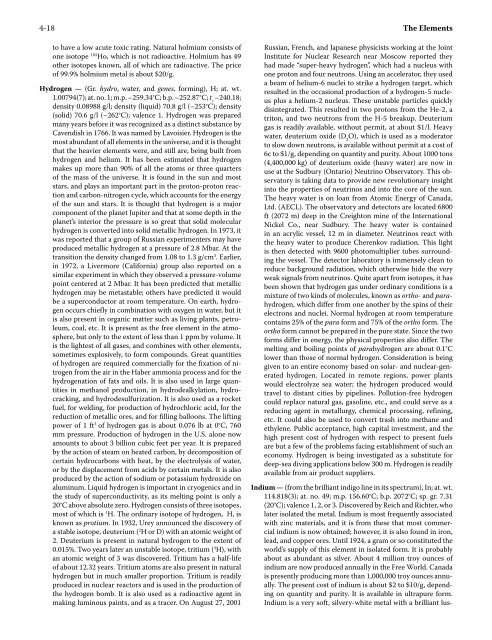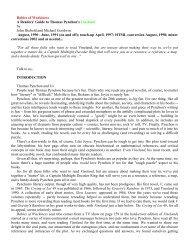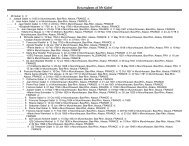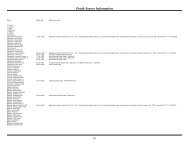CRC Handbook of Chemistry and Physics, 86th Edition
CRC Handbook of Chemistry and Physics, 86th Edition
CRC Handbook of Chemistry and Physics, 86th Edition
You also want an ePaper? Increase the reach of your titles
YUMPU automatically turns print PDFs into web optimized ePapers that Google loves.
4-18 The Elements<br />
to have a low acute toxic rating. Natural holmium consists <strong>of</strong><br />
one isotope 165 Ho, which is not radioactive. Holmium has 49<br />
other isotopes known, all <strong>of</strong> which are radioactive. The price<br />
<strong>of</strong> 99.9% holmium metal is about $20/g.<br />
Hydrogen — (Gr. hydro, water, <strong>and</strong> genes, forming), H; at. wt.<br />
1.00794(7); at. no. 1; m.p. –259.34°C; b.p. –252.87°C; t c –240.18;<br />
density 0.08988 g/l; density (liquid) 70.8 g/l (–253°C); density<br />
(solid) 70.6 g/l (–262°C); valence 1. Hydrogen was prepared<br />
many years before it was recognized as a distinct substance by<br />
Cavendish in 1766. It was named by Lavoisier. Hydrogen is the<br />
most abundant <strong>of</strong> all elements in the universe, <strong>and</strong> it is thought<br />
that the heavier elements were, <strong>and</strong> still are, being built from<br />
hydrogen <strong>and</strong> helium. It has been estimated that hydrogen<br />
makes up more than 90% <strong>of</strong> all the atoms or three quarters<br />
<strong>of</strong> the mass <strong>of</strong> the universe. It is found in the sun <strong>and</strong> most<br />
stars, <strong>and</strong> plays an important part in the proton-proton reaction<br />
<strong>and</strong> carbon-nitrogen cycle, which accounts for the energy<br />
<strong>of</strong> the sun <strong>and</strong> stars. It is thought that hydrogen is a major<br />
component <strong>of</strong> the planet Jupiter <strong>and</strong> that at some depth in the<br />
planet’s interior the pressure is so great that solid molecular<br />
hydrogen is converted into solid metallic hydrogen. In 1973, it<br />
was reported that a group <strong>of</strong> Russian experimenters may have<br />
produced metallic hydrogen at a pressure <strong>of</strong> 2.8 Mbar. At the<br />
transition the density changed from 1.08 to 1.3 g/cm 3 . Earlier,<br />
in 1972, a Livermore (California) group also reported on a<br />
similar experiment in which they observed a pressure-volume<br />
point centered at 2 Mbar. It has been predicted that metallic<br />
hydrogen may be metastable; others have predicted it would<br />
be a superconductor at room temperature. On earth, hydrogen<br />
occurs chiefly in combination with oxygen in water, but it<br />
is also present in organic matter such as living plants, petroleum,<br />
coal, etc. It is present as the free element in the atmosphere,<br />
but only to the extent <strong>of</strong> less than 1 ppm by volume. It<br />
is the lightest <strong>of</strong> all gases, <strong>and</strong> combines with other elements,<br />
sometimes explosively, to form compounds. Great quantities<br />
<strong>of</strong> hydrogen are required commercially for the fixation <strong>of</strong> nitrogen<br />
from the air in the Haber ammonia process <strong>and</strong> for the<br />
hydrogenation <strong>of</strong> fats <strong>and</strong> oils. It is also used in large quantities<br />
in methanol production, in hydrodealkylation, hydrocracking,<br />
<strong>and</strong> hydrodesulfurization. It is also used as a rocket<br />
fuel, for welding, for production <strong>of</strong> hydrochloric acid, for the<br />
reduction <strong>of</strong> metallic ores, <strong>and</strong> for filling balloons. The lifting<br />
power <strong>of</strong> 1 ft 3 <strong>of</strong> hydrogen gas is about 0.076 lb at 0°C, 760<br />
mm pressure. Production <strong>of</strong> hydrogen in the U.S. alone now<br />
amounts to about 3 billion cubic feet per year. It is prepared<br />
by the action <strong>of</strong> steam on heated carbon, by decomposition <strong>of</strong><br />
certain hydrocarbons with heat, by the electrolysis <strong>of</strong> water,<br />
or by the displacement from acids by certain metals. It is also<br />
produced by the action <strong>of</strong> sodium or potassium hydroxide on<br />
aluminum. Liquid hydrogen is important in cryogenics <strong>and</strong> in<br />
the study <strong>of</strong> superconductivity, as its melting point is only a<br />
20°C above absolute zero. Hydrogen consists <strong>of</strong> three isotopes,<br />
most <strong>of</strong> which is 1 H. The ordinary isotope <strong>of</strong> hydrogen, H, is<br />
known as protium. In 1932, Urey announced the discovery <strong>of</strong><br />
a stable isotope, deuterium ( 2 H or D) with an atomic weight <strong>of</strong><br />
2. Deuterium is present in natural hydrogen to the extent <strong>of</strong><br />
0.015%. Two years later an unstable isotope, tritium ( 3 H), with<br />
an atomic weight <strong>of</strong> 3 was discovered. Tritium has a half-life<br />
<strong>of</strong> about 12.32 years. Tritium atoms are also present in natural<br />
hydrogen but in much smaller proportion. Tritium is readily<br />
produced in nuclear reactors <strong>and</strong> is used in the production <strong>of</strong><br />
the hydrogen bomb. It is also used as a radioactive agent in<br />
making luminous paints, <strong>and</strong> as a tracer. On August 27, 2001<br />
Russian, French, <strong>and</strong> Japanese physicists working at the Joint<br />
Institute for Nuclear Research near Moscow reported they<br />
had made “super-heavy hydrogen”, which had a nucleus with<br />
one proton <strong>and</strong> four neutrons. Using an accelerator, they used<br />
a beam <strong>of</strong> helium-6 nuclei to strike a hydrogen target, which<br />
resulted in the occasional production <strong>of</strong> a hydrogen-5 nucleus<br />
plus a helium-2 nucleus. These unstable particles quickly<br />
disintegrated. This resulted in two protons from the He-2, a<br />
triton, <strong>and</strong> two neutrons from the H-5 breakup. Deuterium<br />
gas is readily available, without permit, at about $1/l. Heavy<br />
water, deuterium oxide (D 2 O), which is used as a moderator<br />
to slow down neutrons, is available without permit at a cost <strong>of</strong><br />
6c to $1/g, depending on quantity <strong>and</strong> purity. About 1000 tons<br />
(4,400,000 kg) <strong>of</strong> deuterium oxide (heavy water) are now in<br />
use at the Sudbury (Ontario) Neutrino Observatory. This observatory<br />
is taking data to provide new revolutionary insight<br />
into the properties <strong>of</strong> neutrinos <strong>and</strong> into the core <strong>of</strong> the sun.<br />
The heavy water is on loan from Atomic Energy <strong>of</strong> Canada,<br />
Ltd. (AECL). The observatory <strong>and</strong> detectors are located 6800<br />
ft (2072 m) deep in the Creighton mine <strong>of</strong> the International<br />
Nickel Co., near Sudbury. The heavy water is contained<br />
in an acrylic vessel, 12 m in diameter. Neutrinos react with<br />
the heavy water to produce Cherenkov radiation. This light<br />
is then detected with 9600 photomultiplier tubes surrounding<br />
the vessel. The detector laboratory is immensely clean to<br />
reduce background radiation, which otherwise hide the very<br />
weak signals from neutrinos. Quite apart from isotopes, it has<br />
been shown that hydrogen gas under ordinary conditions is a<br />
mixture <strong>of</strong> two kinds <strong>of</strong> molecules, known as ortho- <strong>and</strong> parahydrogen,<br />
which differ from one another by the spins <strong>of</strong> their<br />
electrons <strong>and</strong> nuclei. Normal hydrogen at room temperature<br />
contains 25% <strong>of</strong> the para form <strong>and</strong> 75% <strong>of</strong> the ortho form. The<br />
ortho form cannot be prepared in the pure state. Since the two<br />
forms differ in energy, the physical properties also differ. The<br />
melting <strong>and</strong> boiling points <strong>of</strong> parahydrogen are about 0.1°C<br />
lower than those <strong>of</strong> normal hydrogen. Consideration is being<br />
given to an entire economy based on solar- <strong>and</strong> nuclear-generated<br />
hydrogen. Located in remote regions, power plants<br />
would electrolyze sea water; the hydrogen produced would<br />
travel to distant cities by pipelines. Pollution-free hydrogen<br />
could replace natural gas, gasoline, etc., <strong>and</strong> could serve as a<br />
reducing agent in metallurgy, chemical processing, refining,<br />
etc. It could also be used to convert trash into methane <strong>and</strong><br />
ethylene. Public acceptance, high capital investment, <strong>and</strong> the<br />
high present cost <strong>of</strong> hydrogen with respect to present fuels<br />
are but a few <strong>of</strong> the problems facing establishment <strong>of</strong> such an<br />
economy. Hydrogen is being investigated as a substitute for<br />
deep-sea diving applications below 300 m. Hydrogen is readily<br />
available from air product suppliers.<br />
Indium — (from the brilliant indigo line in its spectrum), In; at. wt.<br />
114.818(3); at. no. 49; m.p. 156.60°C; b.p. 2072°C; sp. gr. 7.31<br />
(20°C); valence 1, 2, or 3. Discovered by Reich <strong>and</strong> Richter, who<br />
later isolated the metal. Indium is most frequently associated<br />
with zinc materials, <strong>and</strong> it is from these that most commercial<br />
indium is now obtained; however, it is also found in iron,<br />
lead, <strong>and</strong> copper ores. Until 1924, a gram or so constituted the<br />
world’s supply <strong>of</strong> this element in isolated form. It is probably<br />
about as abundant as silver. About 4 million troy ounces <strong>of</strong><br />
indium are now produced annually in the Free World. Canada<br />
is presently producing more than 1,000,000 troy ounces annually.<br />
The present cost <strong>of</strong> indium is about $2 to $10/g, depending<br />
on quantity <strong>and</strong> purity. It is available in ultrapure form.<br />
Indium is a very s<strong>of</strong>t, silvery-white metal with a brilliant lus-







